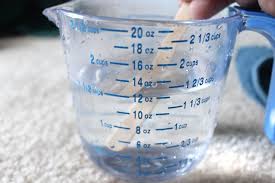MEASURING WATER INTAKE/URINE OUTPUT
Obviously, the first thing to do is collect a urine sample. Measurement of both of these provides very useful information for the vet when urinary symptom problems are suspected. To measure water intake, you must ensure that there is only one source of water available, to which your dog has CONSTANT access. It is best to measure the amount taken over several 24 hour periods and then work out an average of, say, 4 occasions. This eliminates day-to-day variations. A useful routine is:
1. Fill a large container/basin with water up to a specific mark. This should contain MORE water than your dog is likely to drink in 24 hours.
2. Note the time
3. 24 hours later measure the amount of water needed to return the water level exactly to the mark. Measure in millilitres/litres.
4. Obviously, other animals drinking from the same source could lead to confusion and account would need to be taken of this.
A healthy dog should NOT drink more than 100 ml of water per kilogram of body weight per day.
COLLECTING A URINE SAMPLE:
The sample should be as fresh as possible as changes can occur if it is allowed to stand.
Any container used to collect a sample must be absolutely clean and dry. Confusion could easily result if for example traces of sugar were present in a bottle or jar. This may lead to the mistaken finding of glucose in the urine (a symptom of diabetes). The bottle should be washed in hot detergent, rinsed repeatedly and then allowed to dry before it is used for urine.
Try if possible to obtain a “mid-stream” sample from your dog, ie not the very beginning or end of the urine flow. Male dogs are easier to collect from than females. Taping a wide neck container to something like a badminton racket or a plastic bag (without holes in) around a child’s fishing net, can help you pass the container under the bitch while she squats without getting too close and disturbing her – obviously, this container must also be sterile so as not to contaminate the sample.
If you MUST store the sample, enclose it completely in 2 plastic bags which are tied and sealed, and keep in the fridge, preferably in an air tight container.
Another good idea, if getting a sample is tricky and if you have a dog who frequently experiences urinary problems or infections, is to order yourself some of the testing urine strips. These little strips of paper will flag up any problems such as sugars, blood, white cells etc. Simply tape a strip to a long stick, wait until the dog is in “mid-wee” and quickly pop it into the stream of pee. Often, its a lot easier to manage a tiny splash on the strip rather than trying to get a whole sample. It also means that the drop on the strip will be more sterile as it hasn’t been collected in a container which could potentially have contaminants in it, even if you tried very hard to be clean.

